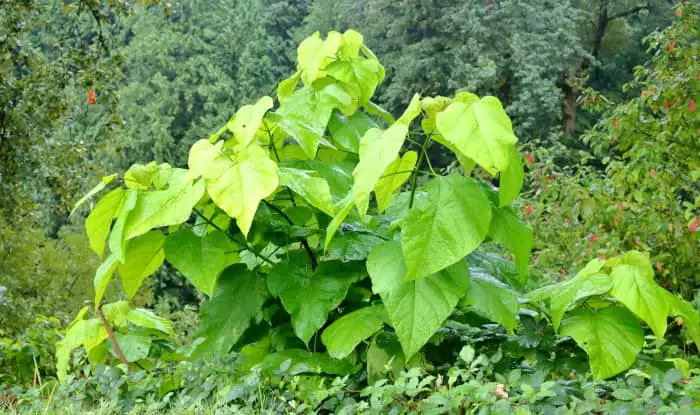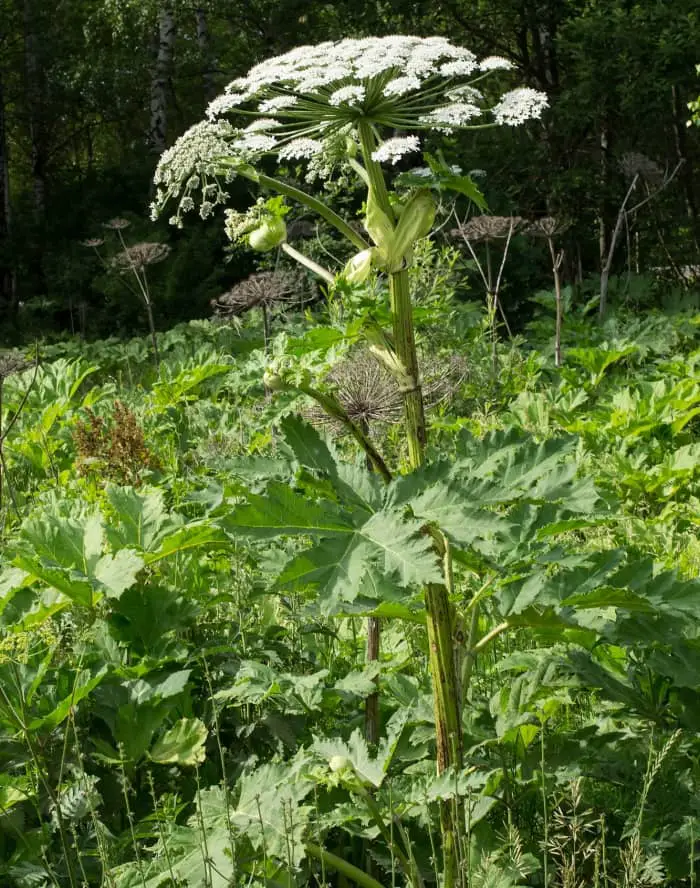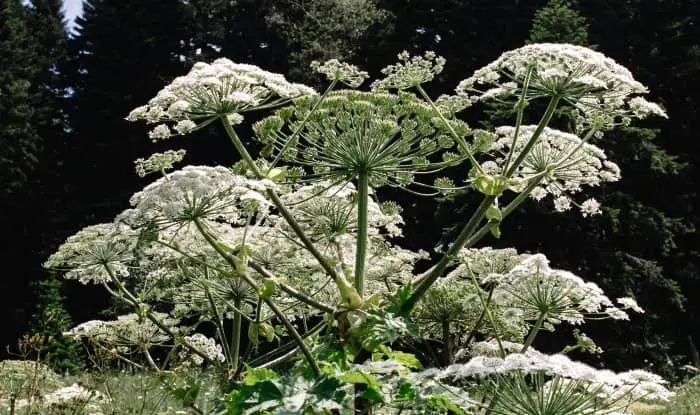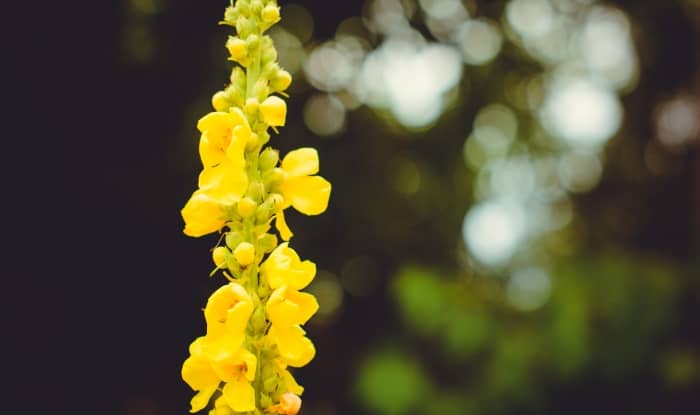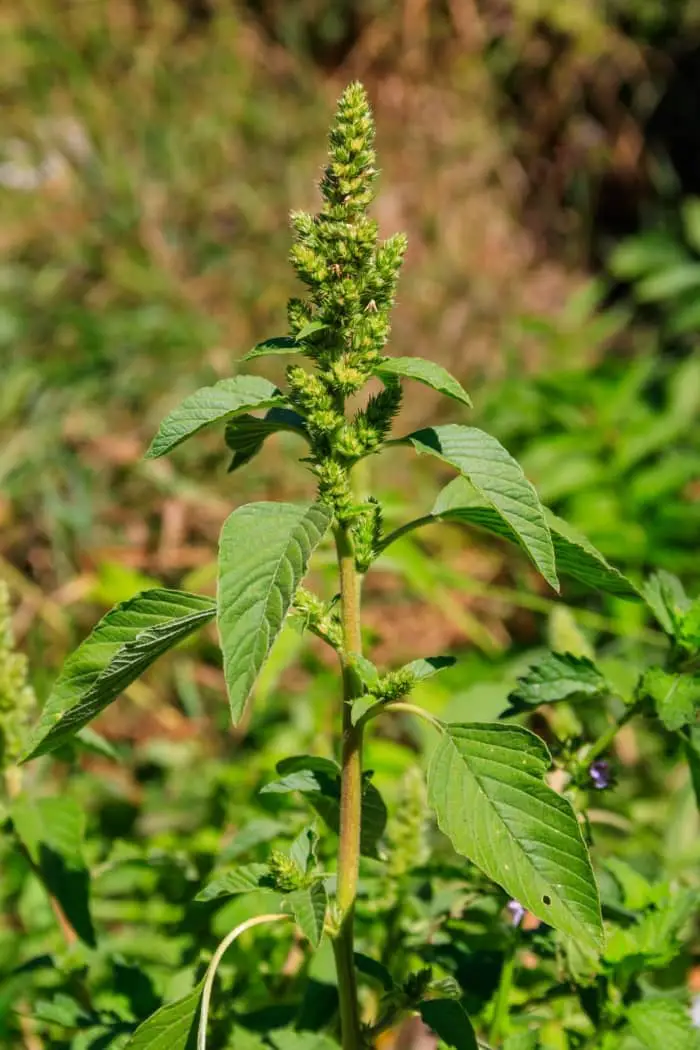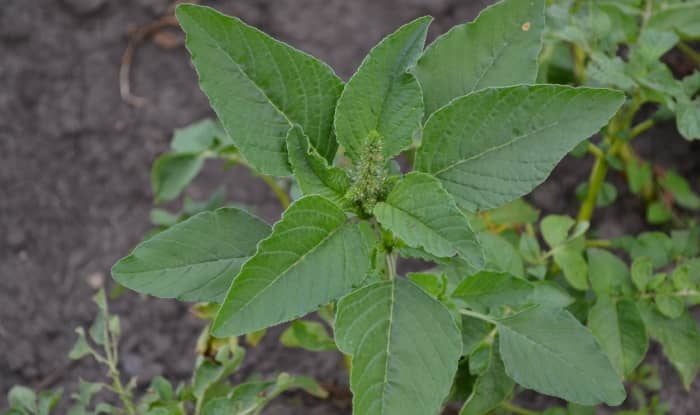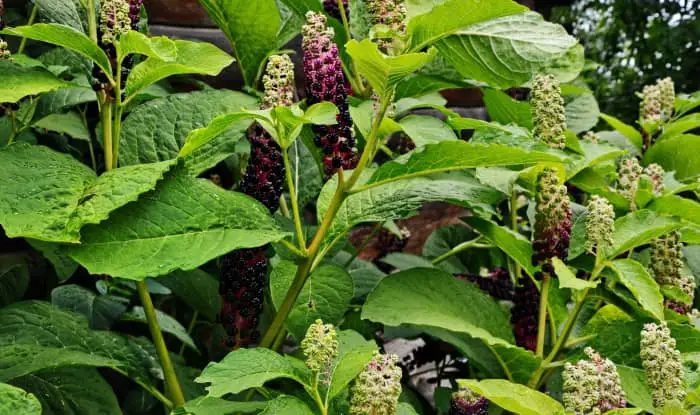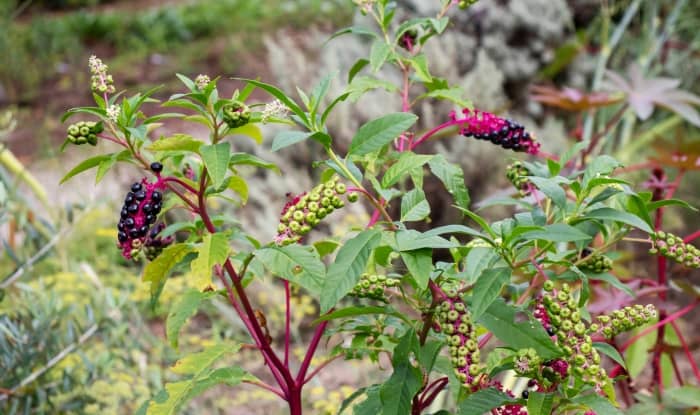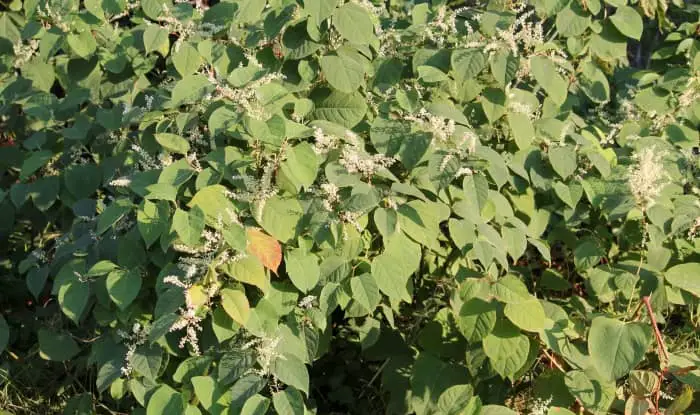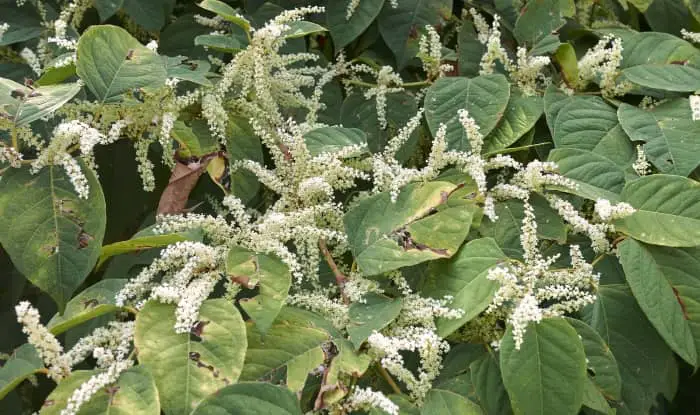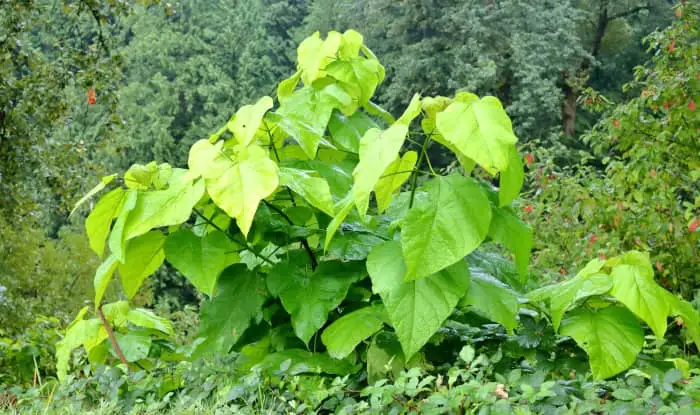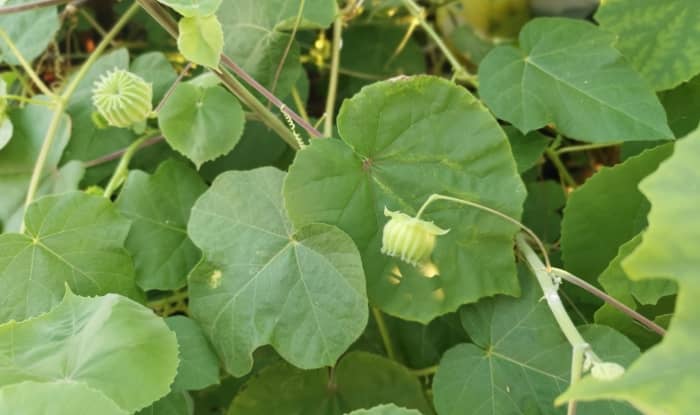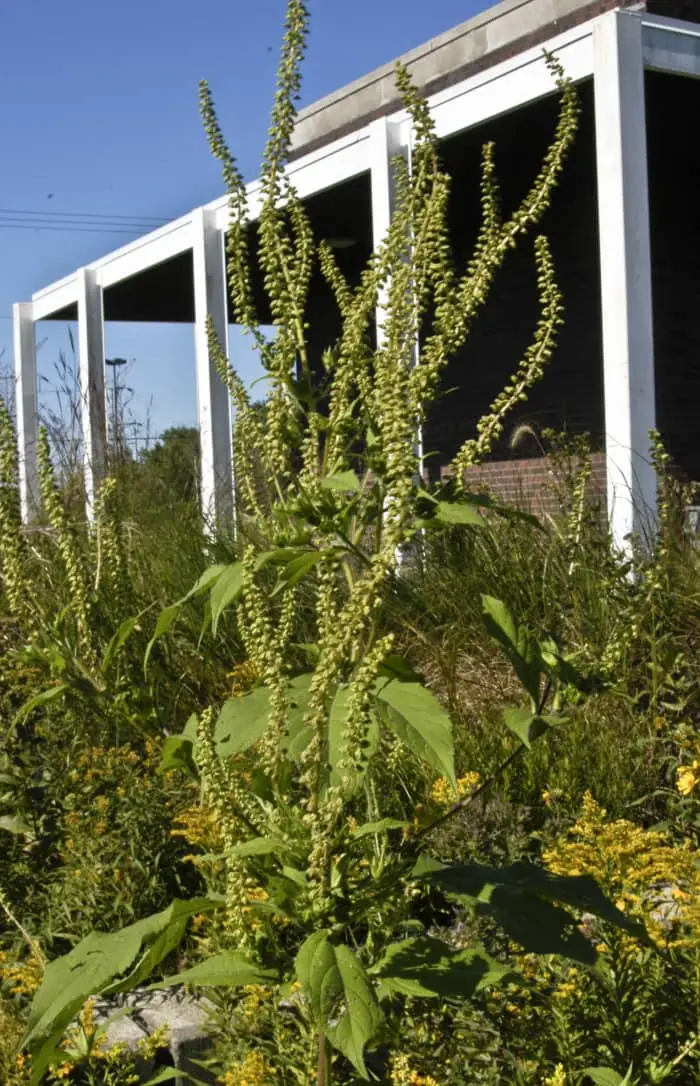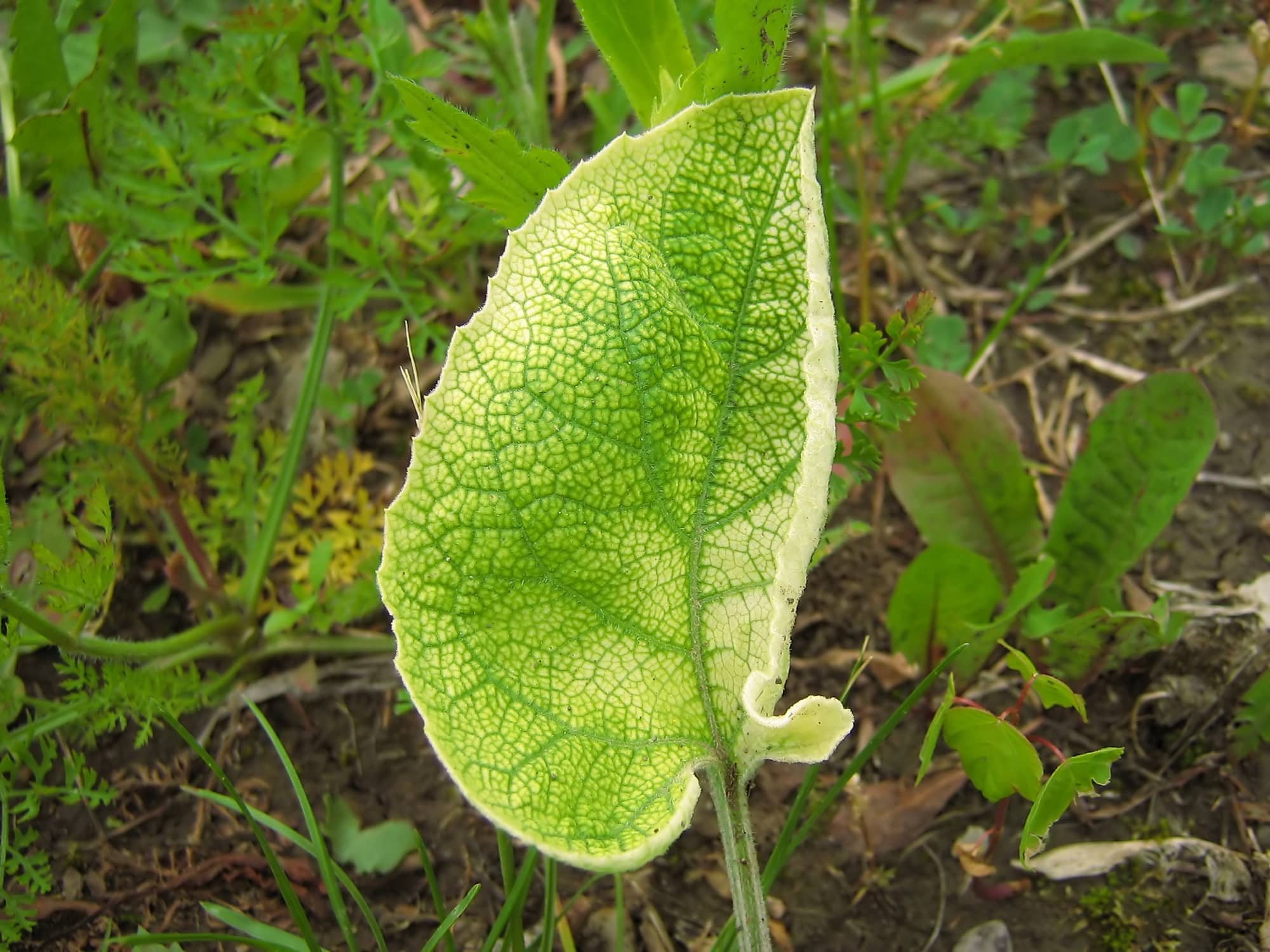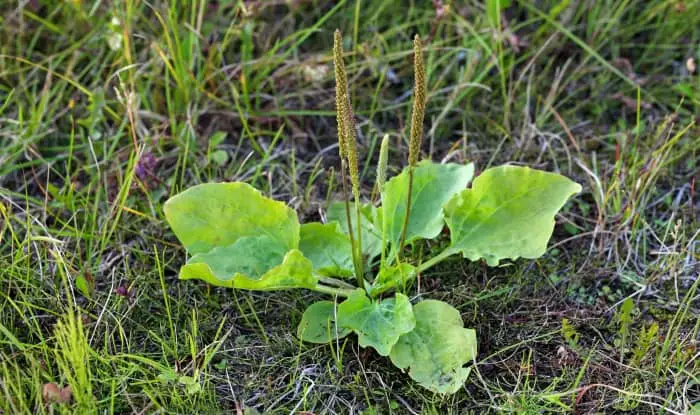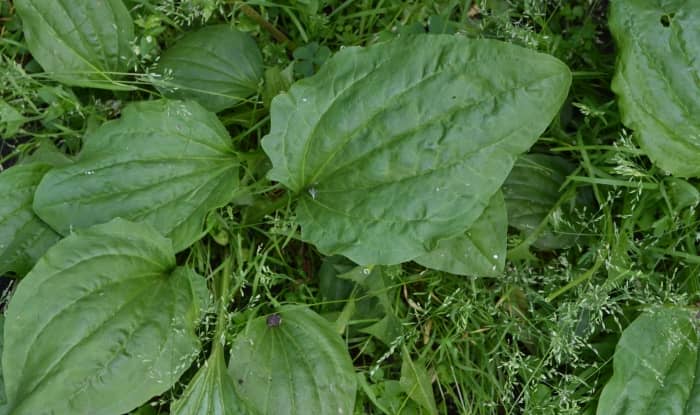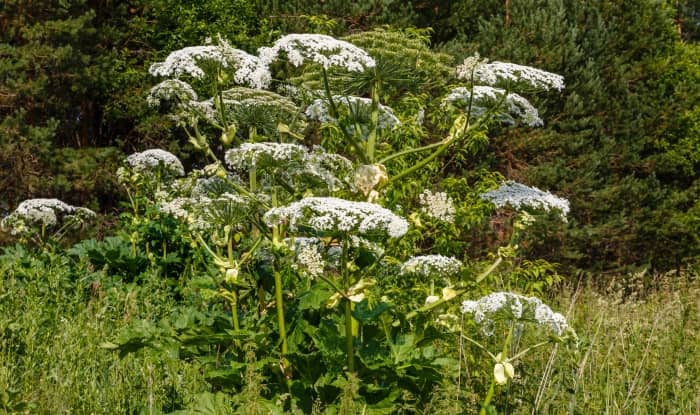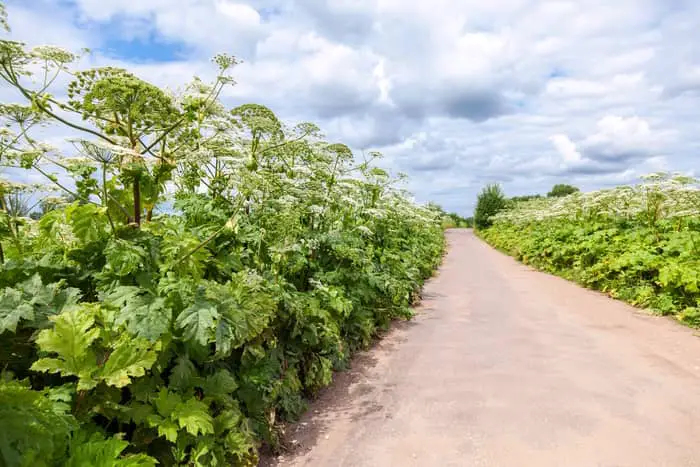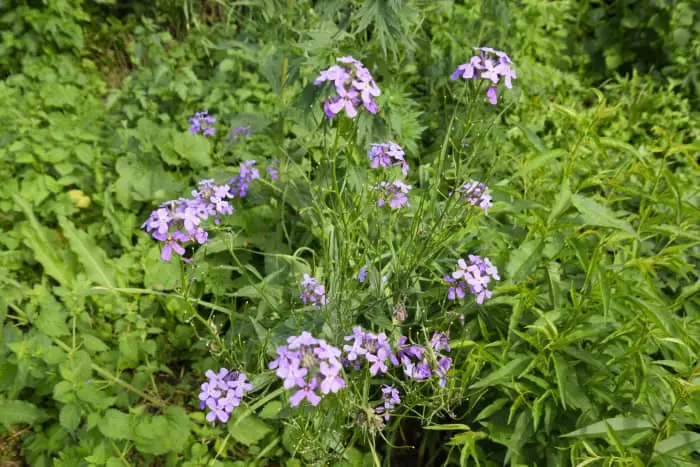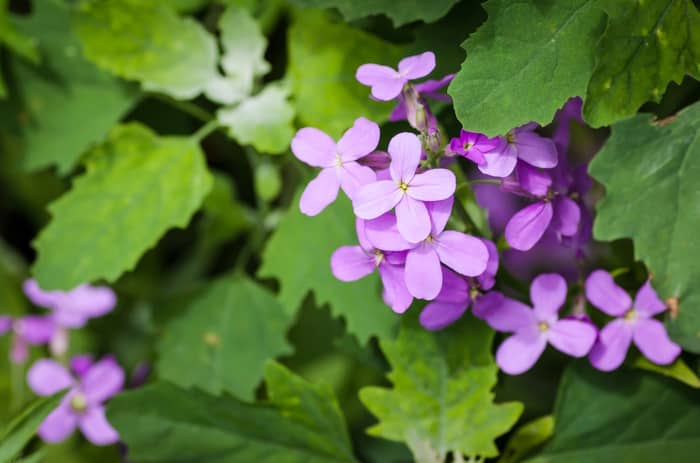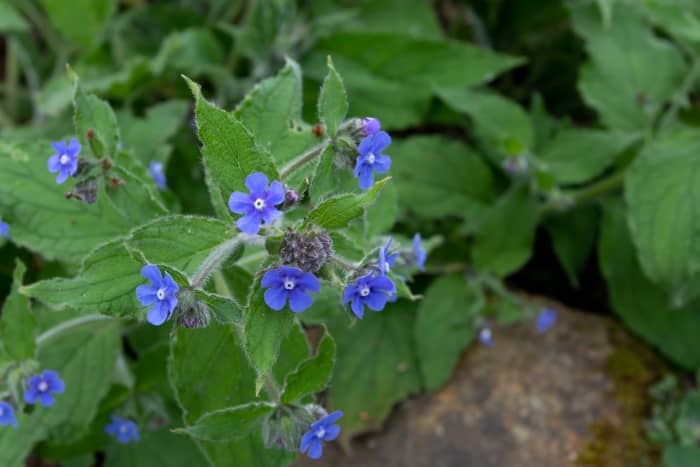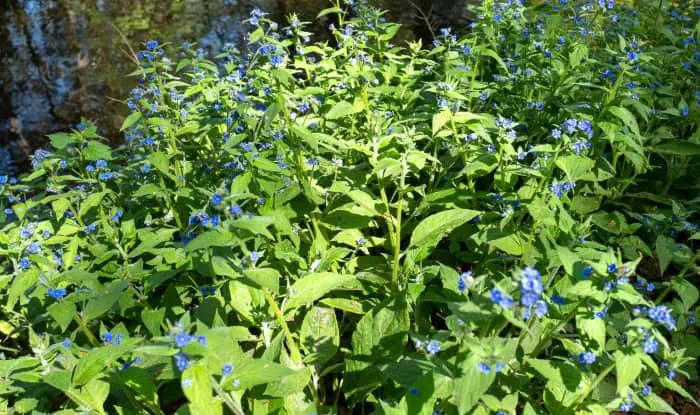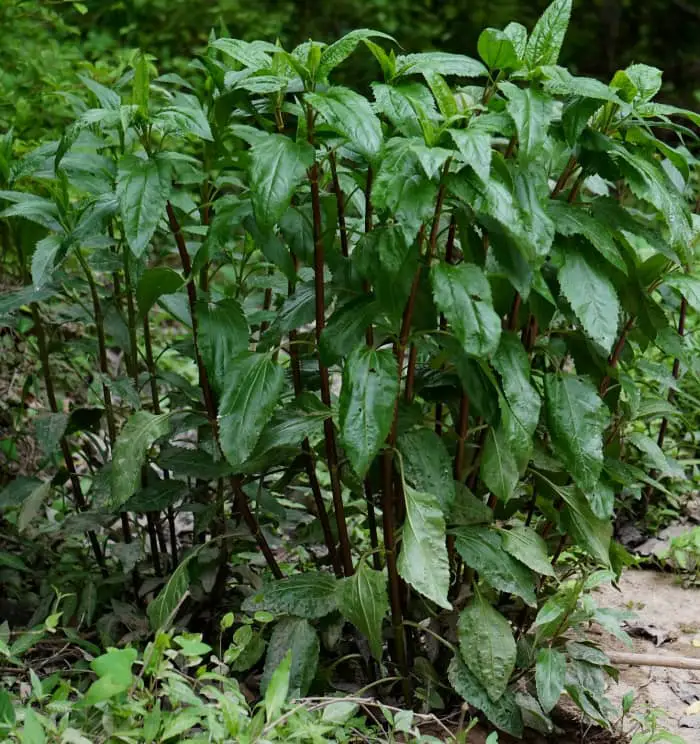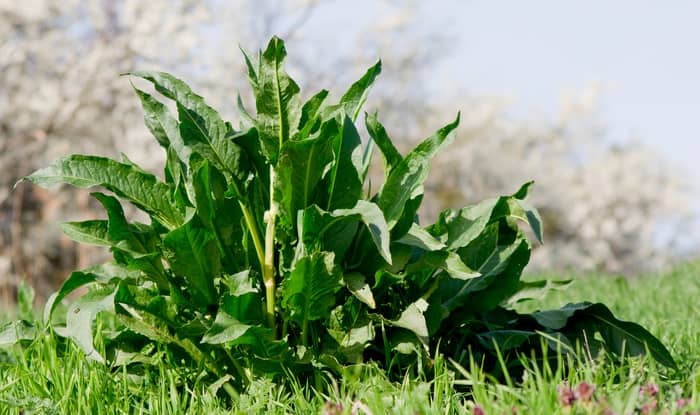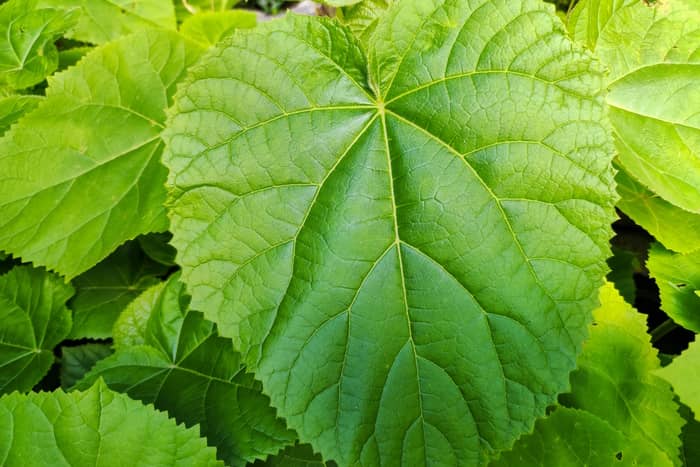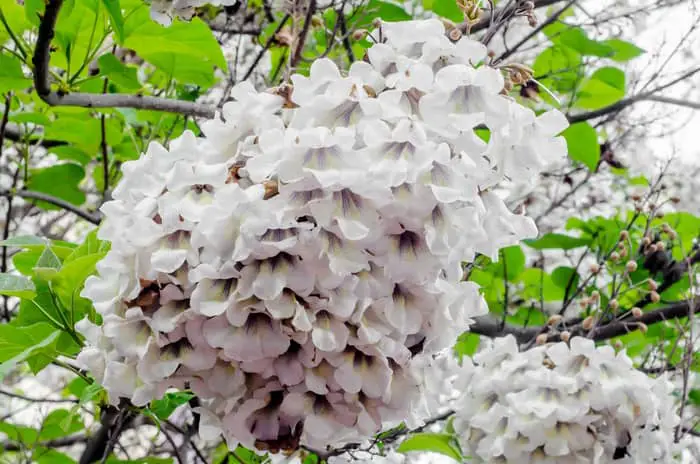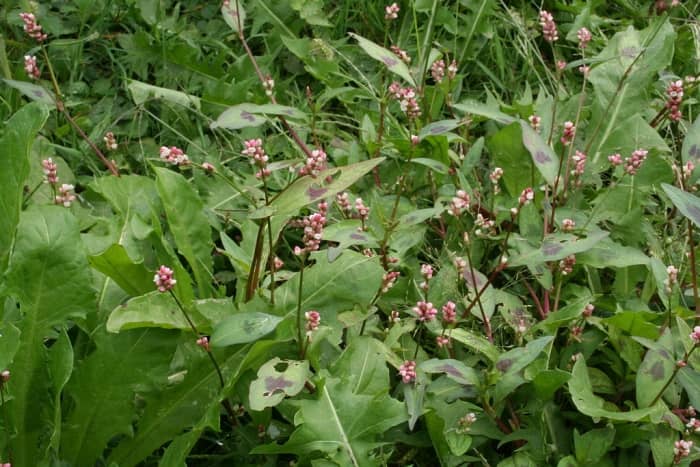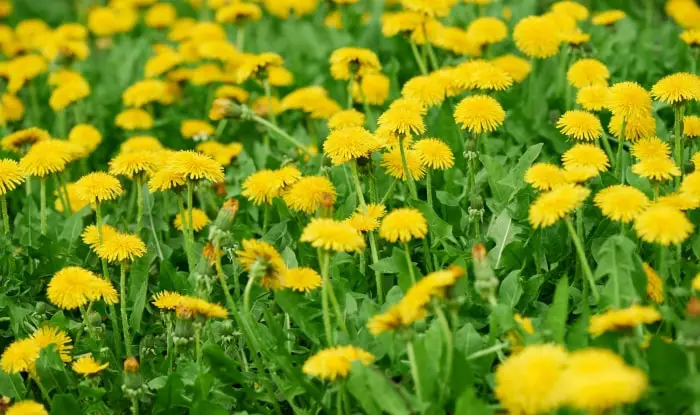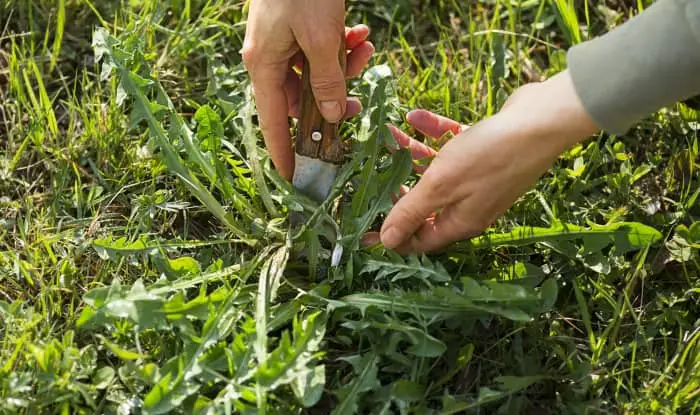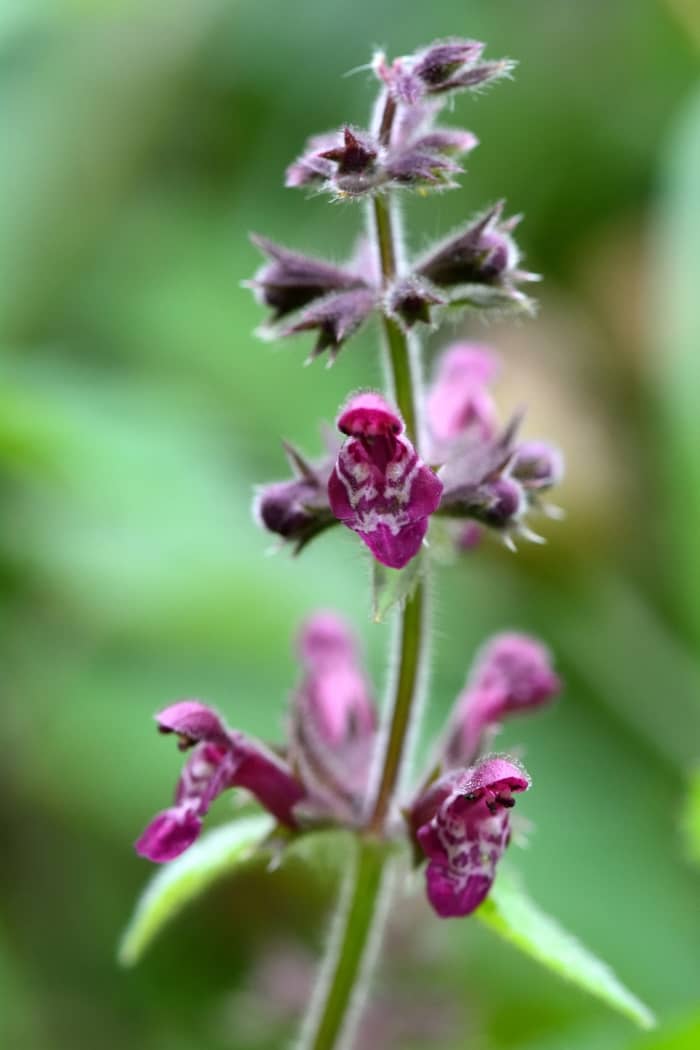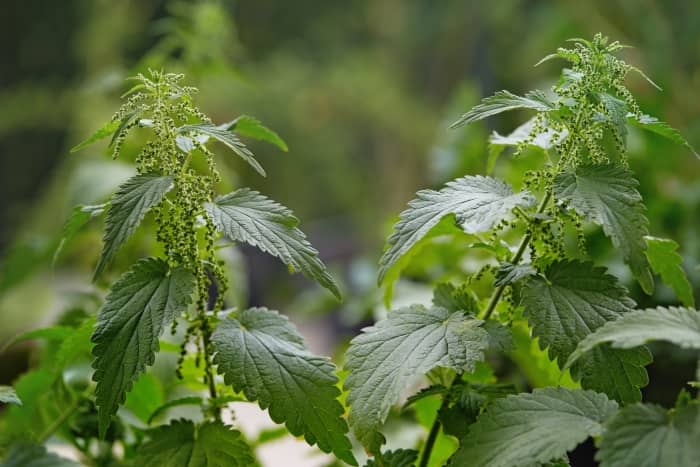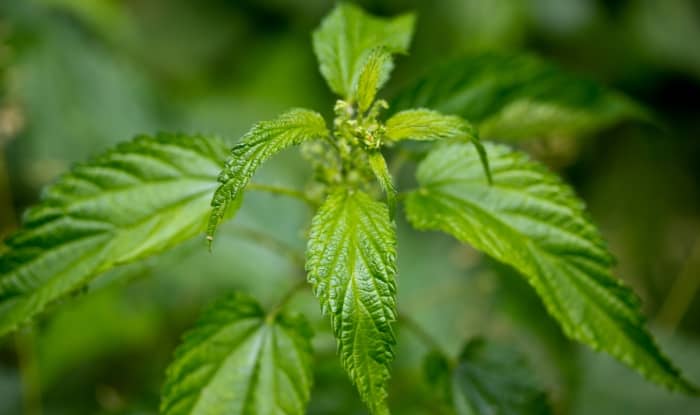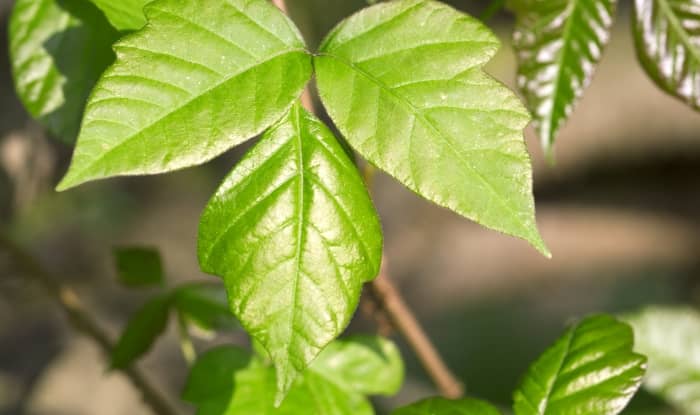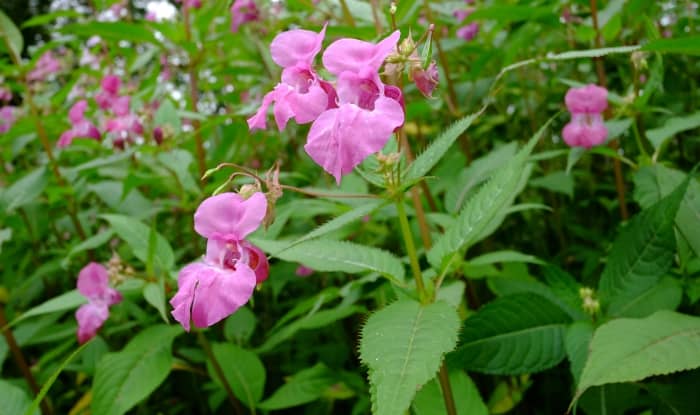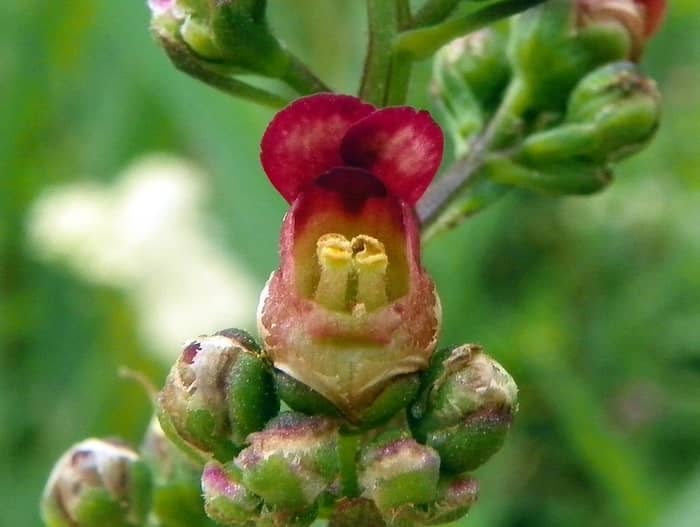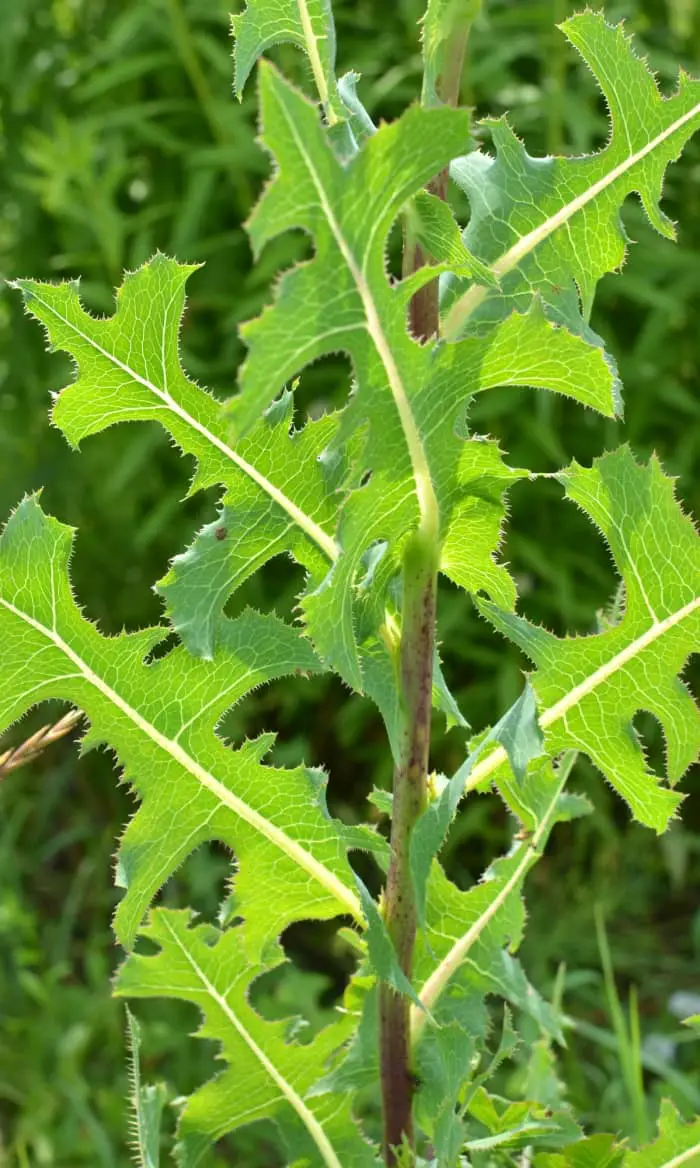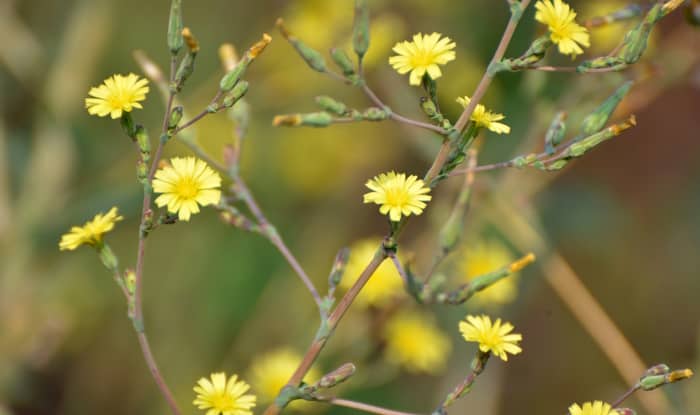It’s not unusual to find weeds with large leaves growing around your property. But it’s important to identify them.
Some weeds are invasive and can quickly take over your yard if left. While other weeds are poisonous if ingested or touched. Making them dangerous for children and animals. And some just spoil the hard work you put into your lawn or landscaping.
Once you’ve successfully identified the weed you can make an effective control plan. So in this guide, I’ll show you 21 of the most common species you’re likely to find.
Let’s dive in.
23 Common Weeds With Large Leaves
These are some of the most common types of weeds with big leaves:
Giant Hogweed (Heracleum mantegazzianum)
Giant hogweed is also called hogsbane and giant cow parsnip. It’s originally native to the Caucasus region of Eurasia. But it was introduced to North America as an ornamental plant, and it’s now considered an invasive weed.
You’ll quickly notice this weed with large leaves when it’s growing on your property, giant hogweed grows up to 18 feet, so it’s hard to miss. The tall weed has a thick central stem and huge leaves that grow up to 5 ft. wide (1). Clusters of white flowers extend on short stalks from a central point at the top of the stem forming an umbrella-like canopy.
Giant hogweed is similar in appearance to other large weeds such as cow parsnip, valerian, lovage, and Queen Anne’s lace. But some important differences help with identification.
To start with, giant hogweed is a taller growing plant than the others. And if you look carefully at the stalk you’ll see bristles and red-purple bumps.
An important word of advice: be careful around giant hogweed, it’s dangerous to handle. The problem?
The plant contains a watery sap that gets on your skin. You won’t notice anything at first. But if you expose the area to sunlight a chemical reaction occurs that causes a painful skin rash, with blisters and burns. So you should wash your hands immediately if you accidentally touch this noxious weed.
Great Mullein (Verbascum thapsus)
Also called common mullein and woolly mullein, great mullein is a giant weed that grows over 7 ft. tall. Great mullein has large grey-green leaves that are thick and oval-shaped. The weed leaves are fuzzy and covered in woolly hairs. The leaves grow from 4-12 inches long and 1-5 inches wide.
Great mullein is a biennial weed. In the first year, the plant grows a basal rosette of furry leaves. And in the second year, the weed develops a tall stem. Great mullein flowers from June to September. With small yellow flowers clustering in a large spike at the top of the stem.
Originally native to Europe, Asia, and North Africa, great mullein is an invasive weed in many areas of North America and Australia.
Pigweed Amaranth (Amaranthus retroflexus)
Pigweed is a summer annual weed that you’ll often find growing around farms, wastelands, prairies, and cultivated fields. It’s a tall weed that grows up to 9 feet. With lance-shaped or oval-shaped green leaves that grow up to 6 inches long from nodes along the central stem.
Pigweed is a highly nutritious, edible weed that’s eaten as a vegetable in many parts of the world. But it can be fatal when fed to pigs and cattle in large quantities because of its high oxalate content.
Pokeweed (Phytolacca Americana)
Pokeweed is a herbaceous perennial that you’ll usually see growing in pastures and around fence rows and forest edges. But you’ll also sometimes find it growing in your garden.
It’s easy to identify pokeweed. To start with, the weed has giant leaves that grow up to 15 inches long and 7 inches wide. The leaves are green and taper at both ends.
When it blooms, pokeweed produces greenish-white flowers. And the plant develops big, juicy, red-black berries.
Experienced foragers sometimes look for pokeweed berries, but most people shouldn’t try to eat them because they’re toxic and require processing in the correct way before being edible.
Japanese Knotweed (Reynoutria japonica)
Japanese knotweed is a perennial broadleaf weed. It’s one of the most troubling weeds with large leaves to find growing on your property. Japanese knotweed is a highly invasive and persistent weed that’s very difficult to get rid of. Often requiring professional help at significant expense to eradicate it.
Japanese knotweed is a fast-growing and aggressive weed. It increases in size by 10 cm per day up to a maximum height of 11 ft. tall. The plant has an extensive network of roots and rhizomes. And sends new shoots up through the surface when necessary to fuel further growth and spread.
You can identify knotweed by its hollow red bamboo-like stems. The leaves are large, green, and heart-shaped with a pointed tip. And they grow from 2-7 inches long. If you rub the leaves they feel thick with a rough texture. In late summer, knotweed flowers. Producing small white flowers that hang in clusters (panicles).
You’ll often see Japanese knotweed growing around riverbanks, roadsides, waste grounds, and hedgerows. But it sometimes encroaches onto people’s property, causing damage to building structures, and growing through paving and tarmac.
Hedge Bindweed (Calystegia sepium)
Hedge bindweed is a perennial herbaceous vine. It has long, mostly hairless stems that twine around vegetation, and climb over fences and walls, clinging to them for support.
The stems are light green to red and have large leaves that grow up to 5 inches long, shaped like an arrowhead. When it blooms, the viney weed produces white or pink trumpet-shaped flowers with leafy bracts at their base.
Hedge bindweed is a noxious weed and grows aggressively, quickly spreading through its rhizomes. The weed also disperses seeds that can remain in your soil for up to 30 years. So it can be very difficult to control bindweed once it becomes established.
Velvetleaf (Abutilon theophrasti)
Growing up to 8 feet, velvetleaf is a tall weed with very large leaves. The weed’s leaves are heart-shaped, green, and covered in short hairs, making them feel velvety.
You’ll find velvetleaf growing in gardens and it’s a common farm field weed. But it’s also common to find this weed growing beside railroad tracks and roadsides.
In some states, velvetleaf is considered a noxious weed. It’s a very competitive plant that takes nutrients and water out of the soil. Preventing crops from getting sufficient quantities and reducing their yield.
And it can be difficult to get rid of. The seeds stay dormant in the soil for a long time. They’re brought to the surface when land is disturbed. And sprout when the soil becomes warm enough in the spring.
In the summer, the plant produces 5-petalled, orange-yellow flowers that grow up to1-Inch in diameter from the leaf axils on short stalks.
You can find more weeds with heart-shaped leaves in our guide.
Giant Ragweed (Ambrosia trifida)
Ambrosia trifida by Frank Mayfield
Giant ragweed is an annual weed found in many parts of North America. It’s difficult to miss if it’s growing in your garden. And it’s easy to identify.
Giant ragweed is a tall weed that grows up to 12 feet. It has a thick green stem, with large leaves that grow up to 12 inches long and 8 inches wide (2). Each leaf has 3-5 lobes. Each lobe is oval-lance shaped and has serrated edges, giving the weed leaves a jagged appearance. At the top of the central stem is a spike of yellow-to-greenish flowers that hang in clusters.
Giant ragweed is a noxious weed. When it invades an area it outcompetes other plants by putting them in the shade, denying them access to sunlight.
Common Burdock (Arctium minus)
Also known as lesser burdock, common burdock is a biannual weed. It’s one of the most common weeds with large leaves to find growing in your yard and on your lawn. You also find it in pastures, paddocks, next to roadsides, and alongside streams.
Identifying burdock is simple. During the first year of growth, the weed develops a basal rosette with large heart-shaped leaves, 6-18 inches long and 4-14 inches wide. The leaves are dark green with fine hairs on the underside. And they have reddish stems that make them resemble rhubarb leaves.
In the second year of growth, burdock sends up a tall hollow stalk that can reach 7 feet high. The plant blooms from July to October, producing lavender to purple flowers at the end of branches and in the leaf axils.
The flower heads resemble a thistle and are covered in spines. Each flowerhead dries up as they age. And turn into prickly burrs with curved spines. The burrs easily hook onto clothing or the fur of animals to spread the seed they contain.
Unlike many weeds with large leaves, common burdock has some uses. The leaves, stalks, and roots are all edible, and you can use them for medicinal purposes.
Broadleaf Plantain (Plantago major)
Broadleaf plantain is also called white man’s foot – a name given to it by Native Americans who associated the plant with the settlers.
It’s a perennial broadleaf weed that’s a common lawn weed. As well as around agricultural land and other disturbed areas of soil.
You can recognize broadleaf plantain by its big leaves that grow in a rosette. Flower stems grow vertically from the center of the weed. With clusters of tiny greenish-brown flowers at their tips that bloom from June to September. The leaves are oval-shaped, smooth, and grow up to 20 cm long.
You can eat the leaves of broadleaf plantain, and they’re highly nutritious. But think carefully before allowing this weed to grow in your garden. Each plant produces up to 20,000 seeds. And they can survive in the soil for a long time. So even after you get rid of the plant, plantain will keep appearing in your yard for many years to come.
Cow Parsnip (Heracleum maximum)
Cow parsnip is closely related to giant hogweed, sharing a similar appearance and many similar attributes. But unlike giant hogweed, cow parsnip is native to North America. You’ll often find it growing in woodlands and grasslands. As well as next to streams, river banks, and roadsides. Cow parsnip spreads by seed, so you might sometimes find this weed growing in your garden.
Cow parsnip is a biennial weed. In the first year, it grows a basal rosette of leaves. And in the second year, the weed develops a tall, thick stalk. When it blooms in May to late June, cow parsnip produces clusters of white flowers that grow from stalks at the top of the stem.
The plant can grow up to 6 ft. tall. And it develops huge leaves that are up to 2 ft. wide (3). The weed’s leaves are hairy, coarse, and consist of 3 deeply lobed leaflets.
Similar to giant hogweed, the plant exudes a sap containing phototoxic chemicals called furanocoumarins. Make sure to wash your hands if you touch the plant. Exposure to the sun while the sap is on your skin results in an itchy rash with blisters and burns.
Dame’s Violet (Hesperis matronalis)
Also called dame’s rocket and damask violet, dame’s violet is a biennial weed, and sometimes a short-lived perennial weed. The plant is originally a native of Asia and Europe. But after introduction as a garden plant, you can now find dame’s violet across many parts of North America where it’s considered an invasive species.
Dame’s violet has bright green leaves that grow up to 5 inches long and 1-½ inches across. The leaves are lance-shaped and taper to a pointed tip. They have toothed edges and both sides are covered in short hairs.
Dame’s violet blooms from May to August. With flowers that vary from purple and lavender to white. The flowers grow in a panicle at the top of stems that can grow up to 3 ft.
Green Alkanet (Pentaglottis sempervirens)
Green alkanet is a perennial weed. The plant grows up to 1 meter tall and has large leaves that grow up to 16 inches long. The leaves are egg-shaped with long petioles joining them to the stem.
When the plant blooms from April to June it produces flowers that resemble forget-me-nots and borage. This makes green alkanet an attractive wildflower. And some people find it makes a nice addition to their garden.
But for many others, green alkanet is a nuisance. The weed spreads quickly in damp and shady gardens. And green alkanet roots are brittle, easily breaking when you try to remove them by hand.
Why is this a problem?
Because green alkanet can regrow from any pieces that are left behind in the soil. Making it difficult to eradicate the weed by pulling or digging it out.
Broad-Leaved Dock (Rumex obtusifolius)
Broad-leaved dock by scizoform
Also known as bitter dock, broad-leaved dock is an invasive perennial weed. Growing up to 60 inches tall, you can identify the weed by its green, broad leaves. The leaves are oval-shaped with rounded tips and can grow up to 16 inches long. If you look closely at them you should see way edges and a reddish tinge to the stems.
If you find a broad-leaved dock plant growing in your yard it’s a good idea to remove it before it sets seed. Each plant produces up to 80,000 seeds that can survive in the soil for decades. Sprouting each year when the conditions are right.
Princess Tree (Paulownia tomentosa)
The princess tree is also known as the empress tree, foxglove tree, and paulownia. It’s an example of a weed tree. And it’s not unusual to find it growing in your yard. Originally from China, the princess tree was introduced to North America as an ornamental. But it’s now considered an invasive species.
Princess tree produces a large number of seeds that germinate easily in areas of disturbed soil. This allows the tree to spread quickly. It’s also fast-growing, increasing its size by up to 5 meters in a single year. The tree can eventually reach a height of 25 meters. But when it’s a sapling, the princess tree looks like a large weed.
The tree has large green leaves that grow up to 12 inches long and 9 inches wide. And princess tree is well-known for its beautiful purple flowers that resemble foxglove.
Redshank (Persicaria maculosa)
Persicaria maculosa (syn. Polygonum persicaria) by Enrico Blasutto, CC BY-SA 3.0
Also called lady’s thumb, redshank is a summer annual weed with large leaves. It’s native to Europe and Asia. And it’s an introduced species in North America, where redshank is now considered an invasive weed.
Redshank grows up to 1 meter tall. The weed has an erect central stem and big leaves arranged alternatingly. The leaves are long and narrow and grow up to 4 inches long and 1 inch wide. They grow from very short stalks and become stalkless the further up the plant you look.
Redshank is a wildflower. And from July to September the plant has a dense spike of tiny pink flowers at the top of the stem.
Dandelion (Taraxacam officinale)
Dandelions are one of the most common types of weeds you’ll find in your garden. When left unchecked, they can quickly take over your lawn.
Dandelions can grow up to 18 inches tall, with large, green, flat leaves and yellow flowers. As the weed matures, the flowers give way to fluffy seed heads. Seed dispersal occurs by the wind.
Dandelion leaves form a basal rosette and can grow quite big, reaching up to 15 inches long. The weed leaves are long, narrow, and lance-shaped. With irregular lobes that are arranged opposite each other. The leaves are often purplish at the base and exude a white sap when cut or broken.
Hedge Woundwort (Stachys sylvatica)
Hedge woundwort is a perennial weed that likes growing in woods and hedges. You’ll also find it around waste ground, along the edges of meadows, and in shaded areas of your garden.
Hedge woundwort grows up to 1 meter tall with a square and hairy stem. The weed has large, toothed leaves with a pointed tip. The leaves grow up to 4 inches long, are covered in hairs, and look similar to nettles.
Hedge woundwort is an eye-catching wildflower. At the top of the erect stalk sits a spire of beautiful purple flowers. But it’s also an invasive weed. Hedge woundwort produces a huge quantity of seeds that help it to spread widely. And it also spreads through underground rhizomes.
This plant also has medicinal properties. You can use hedge woundwort as a herbal remedy for stopping bleeding and healing damaged tissue, hence the name.
Stinging Nettle (Urtica dioica)
A stinging nettle is a herbaceous perennial weed that everyone has a brush with at some point. And that brush is often painful. Because stinging nettle has large, serrated-edged leaves with stinging hairs that cause a painful rash when touched.
Once you’ve had this unpleasant experience you quickly learn to recognize the sight of stinging nettle leaves. They’re dark green and grow up to 6 inches. Growing oppositely on a green, wiry stem. When the weed blooms in the summer it produces clusters of small greenish-white flowers.
Stinging nettles are an invasive weed. The plant produces a large volume of seeds. And also spreads through rhizomes. It’s very difficult to eradicate once it becomes established in an area.
Despite being a weed that most people don’t want anything to do with, it also has some use. Stinging nettles are edible weeds, and you can eat the roots, leaves, and stems. Just remember to cook them first. It’s also a medicinal plant with many health benefits.
Poison Ivy (Toxicodendron radicans)
Poison ivy is a perennial broadleaf weed. It can grow as a ground cover up to 2 ft. tall. A shrub that rises to 4 ft. tall. Or as a climbing vine that can extend up to 100 feet.
Poison ivy leaves typically grow from 2-5 inches. But they can grow up to 8 inches. Each leaf consists of 3 leaflets that are often lobed or toothed. But they can also be smooth-edged. A short stem connects each leaf to the central vine.
Poison ivy can cause a skin rash after you handle it. The plant produces urushiol oil which causes an allergic reaction. So be careful when trying to remove this weed. And wash any areas of skin that come into contact with it.
Himalayan Balsam (Impatiens glandulifera)
Also called Indian jewelweed, copper tops, gnome’s hatstand, and touch-me-not, Himalayan balsam is an annual weed with leaves that grow large when the plant matures.
The weed is native to the Himalayan mountain range, originating between Kashmir and Uttarakhand. In the 19th century, the plant was introduced to North America and Europe as an ornamental but has escaped cultivation and become an invasive weed in many areas.
The weed grows up to 7 feet tall and has smooth, red-purple stems that thicken as the plant matures. Growing from the stems are large oval leaves, pointed at the tips. The leaves grow up to 23 cm long and have toothed margins (4). When crushed, the leaves give off a strong musky smell.
Between June and October, the plant develops clusters of 5-10 pink flowers (sometimes white) at the end of the stems.
Himalayan balsam grows in a variety of soil types, and it’s common to find it along the banks of streams and rivers. Wetlands, roadsides, and forests are other common locations where it grows. Sometimes the weed invades poorly cared-for lawns and gardens.
Common Figwort (Scrophularia nodosa)
SCROPHULARIA NODOSA BY H.ZELL, CC BY-SA 3.0
Common figwort is also called woodland figwort. It mostly grows in temperate regions of North America. You’ll often find it growing in shady areas of your garden. As well as cultivated fields and wastelands.
COMMON FIGWORT BY PETER O’CONNOR
Common figwort grows from 5-10 feet tall. The large leaves grow from succulent, square stems. The leaves are oval-shaped with lanceolate tips and toothed margins. And are arranged opposite each other.
Common figwort produces green-purple flowers from June to September that grow in loose clusters.
Wild Lettuce (Lactuca seriola, Lactuca virosa)
The two most common types of wild lettuce are Lactuca seriola and Lactuca virosa.
Wild lettuce is a biennial or annual herb originally a native of Europe, Asia, and North Africa but now grows in many parts of the world.
When the plant is young, it’s sometimes confused with dandelion because of the similar-looking rosette of leaves that it forms. But when mature, the plant can grow up to 8 feet tall, with a thick, strong stem and long green leaves, with deep notches and spines along the underside central vein.
The leaves can grow up to 12 inches long and 6 inches wide. Leaves towards the bottom of the plant are often deeply lobed and become smaller, unlobed, and smooth-edged closer to the top.
Wild lettuce is a weed that develops pale-yellow flowers on branched stems that look similar to a dandelion flower but smaller.
If you break a stem, the weed will exude a milky sap.
References:
- Giant Hogweed Identification – https://www.dec.ny.gov/animals/72766.html
- Giant Ragweed – https://cals.cornell.edu/weed-science/weed-profiles/giant-ragweed
- Cow Parsnip – https://www.dec.ny.gov/animals/105388.html
- Himalayan Balsam (Impatiens glandulifera) – https://www.invasivespeciescentre.ca/invasive-species/meet-the-species/invasive-plants/himalayan-balsam/
